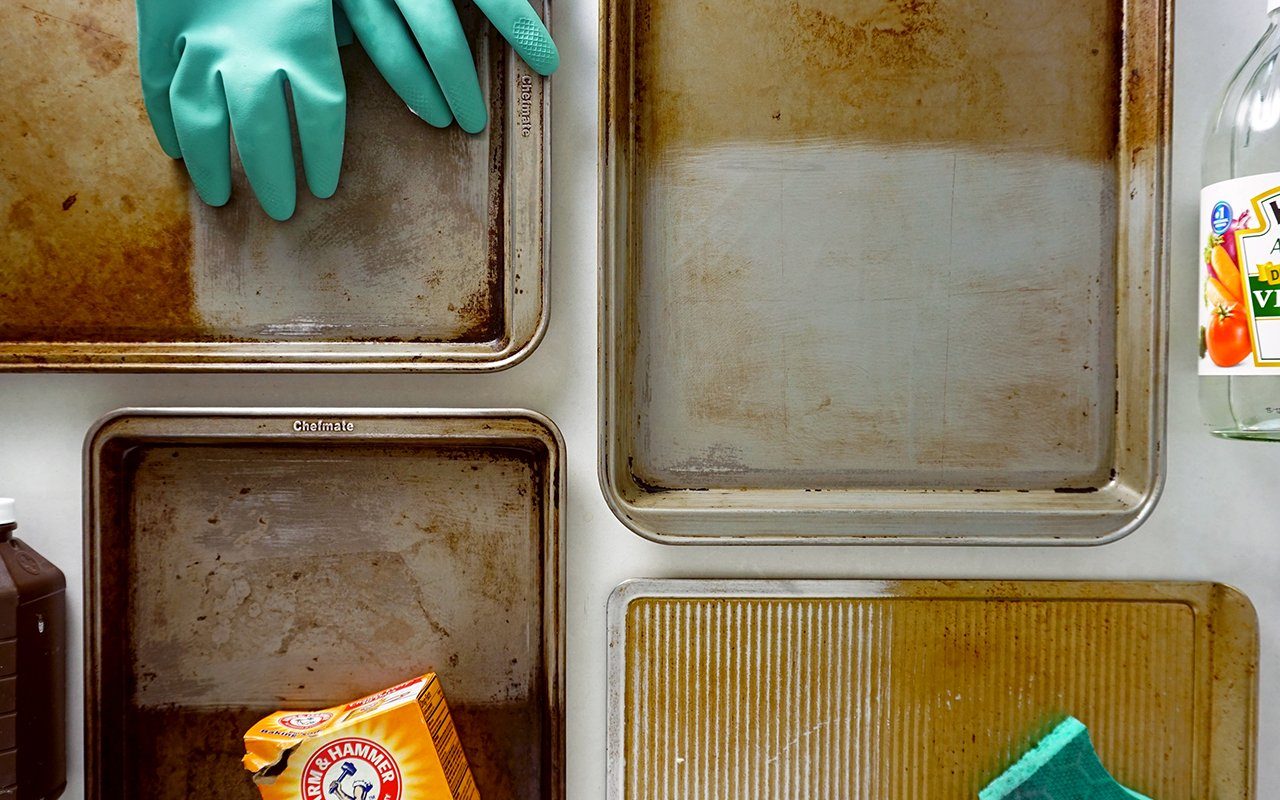
Embarrassed by your grimy baking sheets? You can clean 'em up. To help, we put four popular cleaning methods to the test!
"Put your back into it!"
This is a phrase that should only be heard if you're in the midst of training for an upcoming Strongman Competition. But if a family member is yelling this at you while you're cleaning baking sheets, well, then you're working too hard. Don't feel bad, though. Like us, you may have forgotten the original color of your well-used baking sheets. What was once shiny and bright is now a mottled blend of black and brown that you have accepted as your pan's new look.
But there are ways to breathe scrub new life into your baking sheets! We put four of the most popular cleaning techniques to the test on some dirty baking sheets to see which method was truly up to the challenge.
Keep reading as we explain how each method works, along with our results. Here's how to clean burnt food off of your pans.
How we tested each cleaning method
In cleaning baking sheets, we wanted to have some semblance of a scientific method. Therefore, we not only tested each cleaning method on an individual baking sheet but also divided a single pan into fourths to test the techniques side-by-side. This allowed us to test each method on a pan from a single brand, made out of the same material/coating and with a common mess cooked into the surface. For testing purposes, we also limited scrubbing time to 15 minutes for each method.
Results were then rated on a scale of one to five. Ratings were awarded based on how long each technique took, how much extra elbow grease was required, and the overall ease or difficulty of the cleaning process.
Warning: Before cleaning your pans with any one of these methods, test it on a small, inconspicuous portion of your baking pans to ensure they don't damage the surface of your pans.
Cleaning baking sheets with baking soda + water
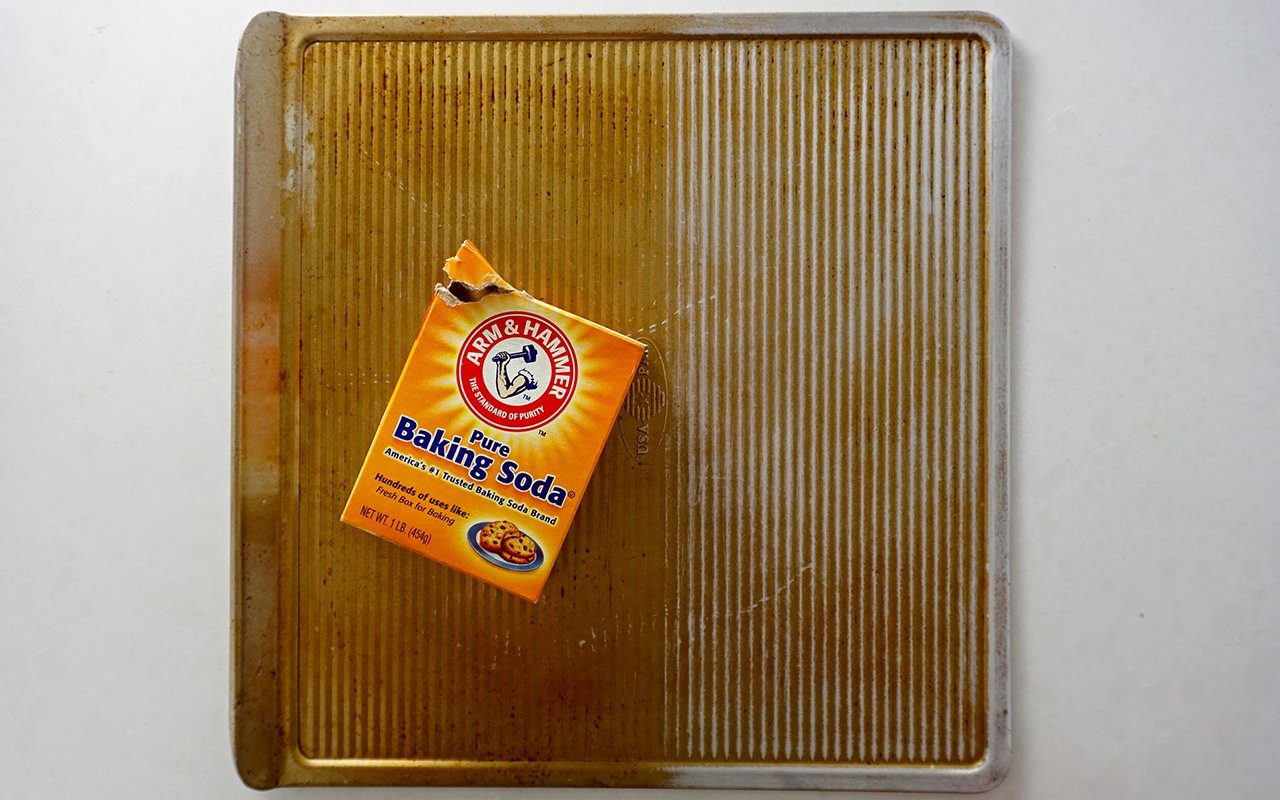
Time: 30 minutes of soaking and 15 minutes of scrubbing
Rating: 3/5
Process: In a small bowl, make a paste out of baking soda and a few tablespoons of clean water. Spread the paste onto the pan and let it sit on the surface of the baking sheet for 30 minutes. Then, scrub away using a nylon pad, sponge, or brush until clean. Give the pan a final wash using dish soap and warm water.
Results: This method took the least amount of time to see results but also required the most elbow grease. This is probably because baking soda alone is not as caustic as a solution paired with an acid like vinegar or hydrogen peroxide. After 15 minutes of scrubbing, there was a visible improvement on the baking sheets we tested but deep, set-in stains were still present. This method may be best for pans with lighter staining or nonstick pans since more abrasive solutions may damage the coating. Learn if it's safe to store your pans in the oven drawer.
Cleaning baking sheets with baking soda + white vinegar
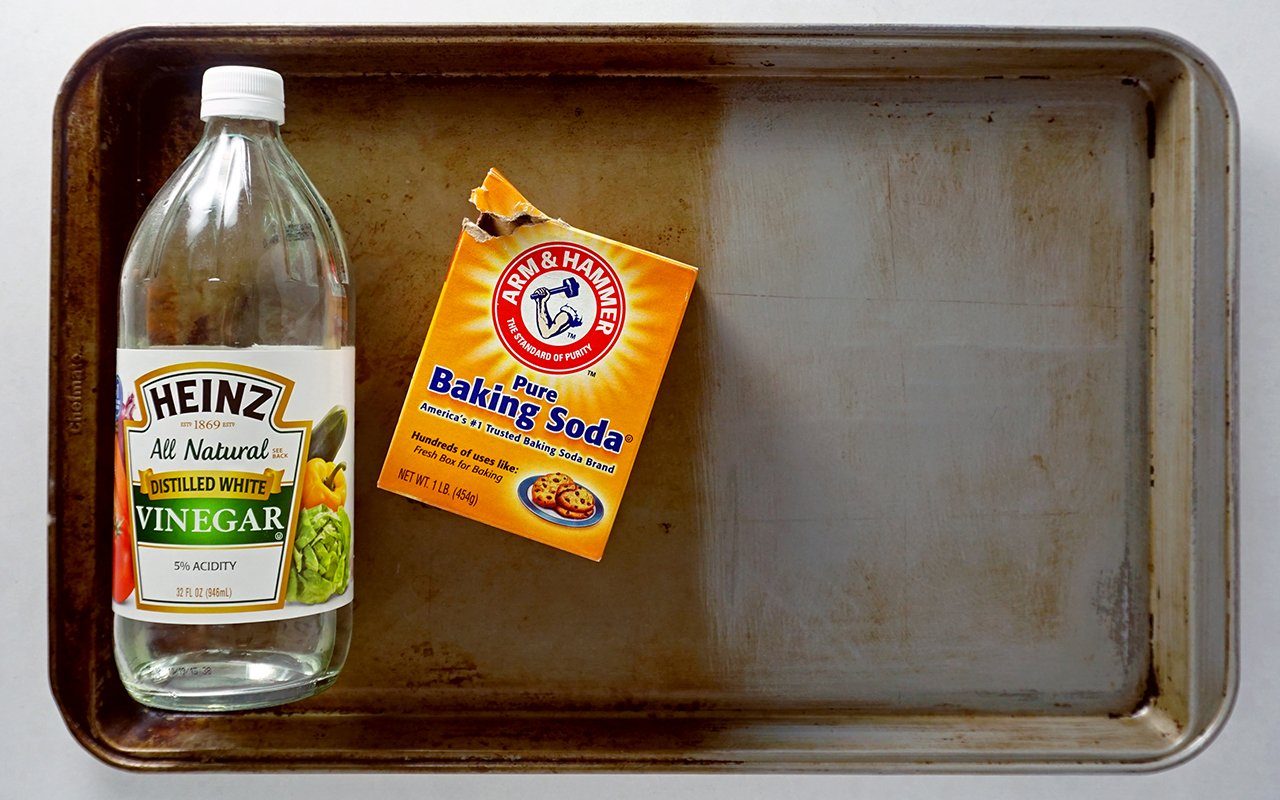
Time: 60 minutes of soaking and 15+ minutes of scrubbing
Rating: 4/5
Process: Measure out a 1:1 ratio of baking soda to white vinegar, about 1/4 cup of each. Then, sprinkle the baking soda over the dirty pan and pour the vinegar over the surface. Let the two products begin to react. Meanwhile, fill a sink with hot, clean water. Submerge the pan in the hot water and let it soak for 30-60 minutes. After soaking, use a nylon pad or steel wool to scrub away the grime. Wash again using dish soap and warm water, rinse and dry.
Results: This method really worked well. After a 60-minute soak in hot water and 15 minutes of scrubbing, nearly all the stains and grime were removed. The only reason we docked a point is we did need to use considerable scrubbing power to get the heaviest stains to lift. With that being said, we do think another 3-5 minutes of scrubbing would have probably lifted the remaining stains completely. Try these other vinegar cleaning hacks.
Cleaning baking sheets with hydrogen peroxide
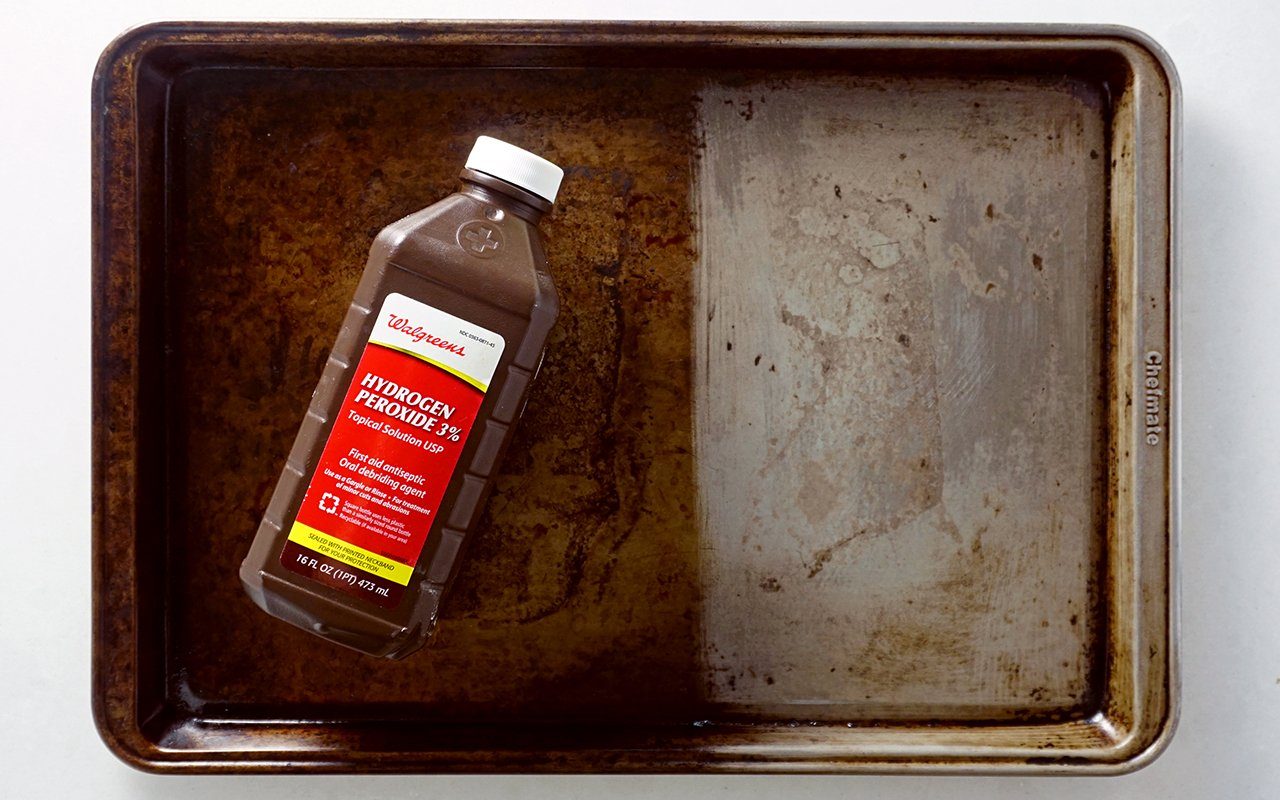
Time: 6 hours of soaking and 15 minutes of scrubbing
Rating: 2/5
Process: While wearing rubber gloves, soak a damp paper towel or dishcloth with hydrogen peroxide. Rub the cloth gently over the surface of the baking pan to saturate the surface, then lay the cloth flat over the pan to cover it. If you're working on a large pan, you may need to use multiple paper towels or dishcloths to cover the entire surface. Let the pan sit for at least 2 hours or up to 8 hours for really tough messes. Then, remove the cloth and scrub the pan in hot water using a scouring pad to lift the remaining stains. Wash thoroughly with dish soap and rinse in clean water.
Results: Similar to baking soda alone, hydrogen peroxide on its own doesn't quite have the punch it needs to lift heavy food stains. This method lost points because it not only lacks potency but also took a lot of time to soak. We will say that light stains lifted easier with this method than those involving baking soda solutions. However, once those light stains were gone it didn't have much impact on the deeper stains.
Cleaning baking sheets with baking soda + hydrogen peroxide
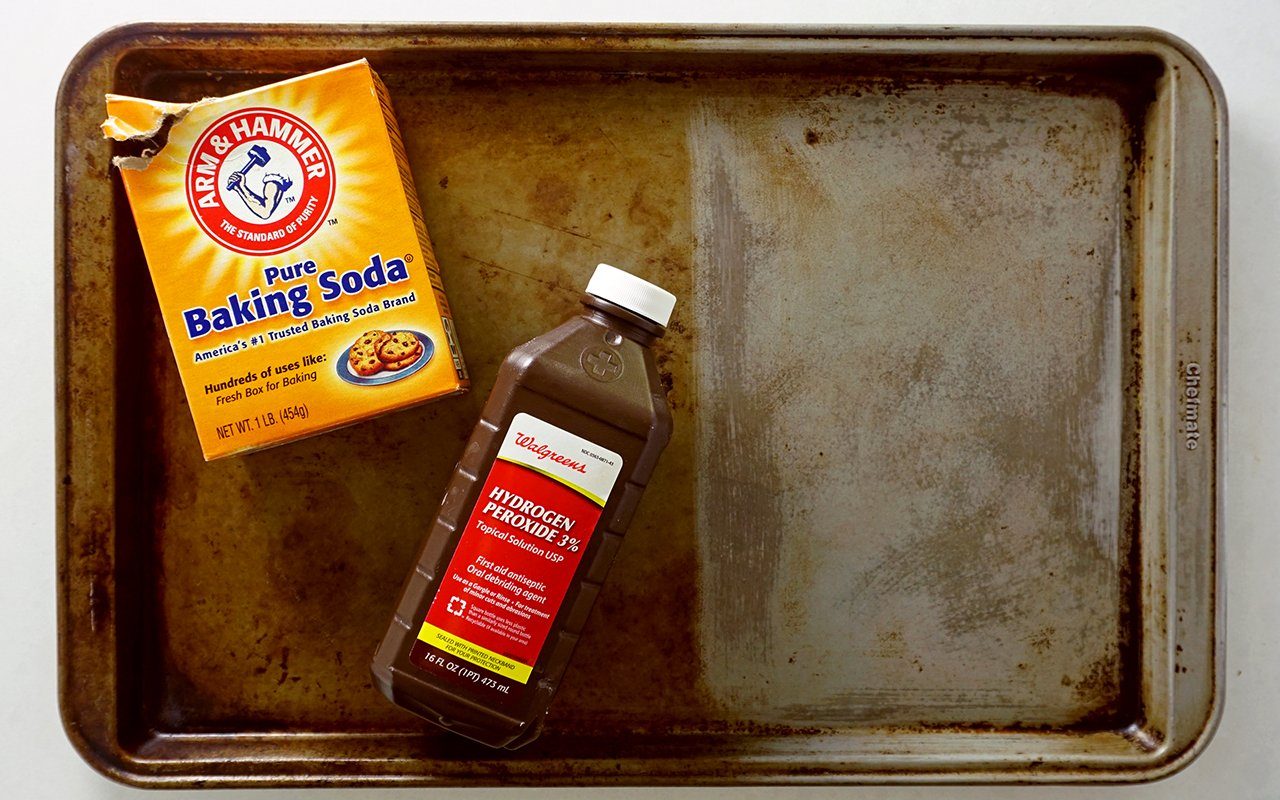
Time: 6 hours of soaking and 15 minutes of scrubbing
Rating: 4/5
Process: Using a 1:1 ratio of baking soda and hydrogen peroxide, form a paste by mixing the two together in a small bowl. Spread the paste evenly over the surface of the baking sheet. Let the paste sit on the pan for at least 2 hours or up to 8 hours for bigger messes. After time has elapsed, wipe away the mixture from the baking pans using a paper towel and water. Scrub any remaining residue away using a nylon pad, sponge, or brush and then give the pan a final wash with dish soap and hot water to thoroughly clean.
Results: This method was just about as effective as the baking soda and vinegar solution. While the vinegar-based solution lost a point because it required heavier scrubbing, this method loses a point because of how much time it requires. Stains lifted easily with this method, requiring only a light hand to scrub. However, those results were only possible due to the longer soaking time, which may not always be convenient. Here are some other uses for hydrogen peroxide you've never thought about.
Final thoughts
Overall, all four methods were effective at lifting grime and giving new life to the baking sheets. While none of the methods received a perfect score, we still think each method has its merits depending on how much time you're willing to invest. Ultimately, it comes down to investing either time or effort.
Personally, we'll stick with a baking soda and vinegar solution to deep-clean our baking sheets if we're short on time, and reserve a baking soda and hydrogen peroxide solution for big messes that require extra time to lift set-in stains.
Warning: If, after reading this, you're wondering why we also didn't try a solution combining baking soda, vinegar, AND hydrogen peroxide, it's because that combination is dangerous. When mixed together, vinegar and hydrogen peroxide create what's called peracetic acid, which is potentially toxic and can irritate the skin, eyes, and respiratory system.
Now that your baking pans are clean as a whistle, there's only one thing to do: make 'em dirty again. Now, try cleaning the rest of your kitchen. Here's how to do it in basically five minutes.

We Tried 4 Methods for Cleaning Baking Sheets and Found the Best, Source:https://www.rd.com/article/methods-for-cleaning-baking-sheets/